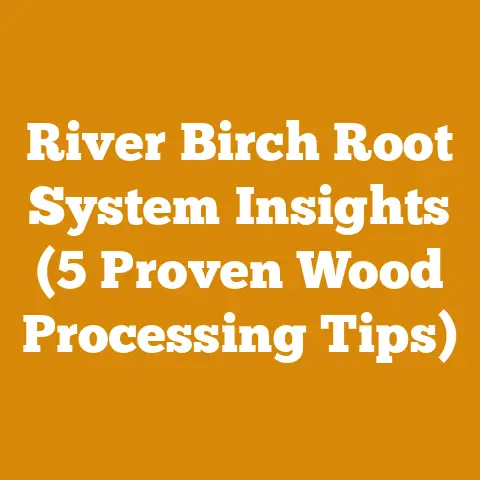Stihl BR 430 Backpack Blower Review (Pro Tips for Wood Processing)
Stihl BR 430 Backpack Blower Review (Pro Tips for Wood Processing): Power, Performance, and Practicality
The Stihl BR 430 backpack blower is a powerful tool that can significantly streamline wood processing operations. While a blower might not be the first thing that comes to mind when you think of logging or firewood prep, trust me – it’s a game-changer. From clearing debris around the worksite to speeding up drying times for your freshly split wood, a good blower is an unsung hero. In this review, I’ll dive deep into the BR 430, sharing my experiences and providing pro tips on how to integrate it into your wood processing workflow, all while keeping a close eye on the bottom line. Installation is pretty straightforward. The blower comes mostly assembled, and attaching the tubes and adjusting the harness takes only a few minutes.
Why a Backpack Blower for Wood Processing? My Personal Experience
For years, I relied on rakes, brooms, and sheer elbow grease to keep my wood processing area clean. It was back-breaking work, especially after a long day of felling, bucking, and splitting. Then, I decided to give a backpack blower a try. The difference was immediate. Suddenly, I could clear sawdust, wood chips, and leaves from around my sawmills, log piles, and drying racks in a fraction of the time. Not only did it save me time and energy, but it also improved safety by reducing slip hazards and making it easier to spot dropped tools.
One of the biggest advantages I found was in speeding up the drying process for firewood. By using the blower to remove surface moisture after a rain shower, I could significantly reduce the time it took for the wood to reach optimal moisture content for burning. This meant I could sell seasoned firewood faster and avoid the losses associated with rotting or moldy wood.
Stihl BR 430: Features and Specifications
The Stihl BR 430 is a mid-range backpack blower designed for both homeowner and professional use. Here’s a breakdown of its key features:
- Engine: 63.5 cc, 4-MIX® engine
- Air Volume: 623 cfm (cubic feet per minute)
- Air Velocity: 194 mph
- Weight: 22.7 lbs
- Fuel Capacity: 47.3 oz
- Sound Level: 75 dB(A)
- Starting System: Easy2Start™
- Carrying Comfort: Ergonomic harness with adjustable straps
The 4-MIX® engine is a key feature of the BR 430. It combines the advantages of a 2-stroke and 4-stroke engine, offering high torque, lower emissions, and easier maintenance compared to traditional 2-stroke blowers. The Easy2Start™ system is another welcome addition, making starting the blower a breeze, even in cold weather.
The ergonomic harness is designed for comfort, even during extended use. The adjustable straps allow you to customize the fit to your body, distributing the weight evenly and reducing strain on your back and shoulders.
Performance in Wood Processing Scenarios
I’ve put the BR 430 through its paces in a variety of wood processing scenarios, and here are my observations:
- Sawmill Cleanup: The BR 430 is excellent for clearing sawdust and wood chips from around sawmills and other woodworking equipment. Its powerful airflow can quickly remove even heavy accumulations of debris, keeping your workspace clean and safe.
- Log Pile Maintenance: Keeping log piles clear of leaves, needles, and other organic matter is crucial for preventing rot and insect infestations. The BR 430 makes quick work of this task, allowing you to maintain healthy log piles and maximize the value of your timber.
- Firewood Drying: As mentioned earlier, the BR 430 can significantly speed up the drying process for firewood. By removing surface moisture and improving air circulation around the woodpile, it helps to prevent mold and rot and reduces the time it takes for the wood to reach optimal moisture content.
- Trail Clearing: If you’re working in the woods, the BR 430 can be used to clear trails and paths, making it easier to move logs and equipment. It’s also useful for removing debris from around felled trees, making them easier to buck and limb.
Stihl BR 430: Cost Analysis and Budgeting
Now, let’s get down to the nitty-gritty: cost. The Stihl BR 430 typically retails for around $450-$550, depending on your location and the dealer. However, the initial purchase price is just one piece of the puzzle. To get a true understanding of the cost of owning and operating the BR 430, you need to consider the following factors:
- Fuel Costs: The BR 430 uses a gasoline-oil mix, so you’ll need to factor in the cost of both gasoline and 2-stroke oil. Fuel consumption will vary depending on the type of work you’re doing, but I’ve found that a full tank of fuel typically lasts me for about 1.5-2 hours of continuous use.
- Maintenance Costs: Like any piece of equipment, the BR 430 requires regular maintenance to keep it running smoothly. This includes changing the air filter, spark plug, and fuel filter, as well as lubricating the moving parts. I typically spend about $50-$75 per year on maintenance parts and supplies.
- Repair Costs: While the BR 430 is a well-built machine, it’s not immune to breakdowns. Repair costs can vary widely depending on the nature of the problem, but I’ve budgeted about $100 per year for potential repairs.
To help you get a better handle on the costs, I’ve created a sample budget for owning and operating the Stihl BR 430:
| Cost Item | Annual Cost | Notes |
|---|---|---|
| Purchase Price (Amortized over 5 years) | $90-$110 | Assuming a purchase price of $450-$550 and a lifespan of 5 years. |
| Fuel Costs | $100-$200 | Based on 1.5-2 hours of use per tank, 2 tanks per month, and a fuel cost of $3-$4 per gallon. |
| Maintenance Costs | $50-$75 | Includes air filters, spark plugs, fuel filters, and lubricants. |
| Repair Costs | $100 | Budgeted for potential repairs. |
| Total Annual Cost | $340-$485 |
Note: These are just estimates, and your actual costs may vary depending on your usage patterns and local prices.
Cost Optimization Tips
Here are some tips for reducing the cost of owning and operating the Stihl BR 430:
- Buy Fuel in Bulk: Purchasing gasoline and 2-stroke oil in bulk can save you a significant amount of money over time. Consider buying a 5-gallon gas can and a quart of 2-stroke oil to take advantage of bulk discounts.
- Perform Regular Maintenance: Regular maintenance is key to preventing costly repairs. Follow the manufacturer’s recommendations for maintenance intervals and be sure to use high-quality parts and supplies.
- Shop Around for Parts: Don’t just buy your parts from the first place you see. Shop around online and at local dealers to find the best prices.
- Consider a Refurbished Model: If you’re on a tight budget, consider buying a refurbished Stihl BR 430. Refurbished models are typically cheaper than new ones, and they often come with a warranty.
Integrating the BR 430 into Your Wood Processing Workflow
The Stihl BR 430 can be integrated into your wood processing workflow in a variety of ways. Here are a few examples:
- Sawmill Cleanup: Use the BR 430 to clear sawdust and wood chips from around your sawmill after each milling session. This will help to keep your workspace clean and safe and prevent the accumulation of debris.
- Log Pile Maintenance: Use the BR 430 to remove leaves, needles, and other organic matter from your log piles on a regular basis. This will help to prevent rot and insect infestations and maximize the value of your timber.
- Firewood Drying: Use the BR 430 to remove surface moisture from your firewood after a rain shower. This will help to speed up the drying process and prevent mold and rot.
- Trail Clearing: Use the BR 430 to clear trails and paths in the woods, making it easier to move logs and equipment.
Safety Considerations
When using the Stihl BR 430, it’s important to follow these safety precautions:
- Wear appropriate personal protective equipment (PPE), including eye protection, hearing protection, and a dust mask.
- Read and understand the owner’s manual before operating the blower.
- Keep children and pets away from the work area.
- Never point the blower at people or animals.
- Be aware of your surroundings and watch out for hazards such as rocks, roots, and uneven terrain.
- Do not operate the blower in enclosed spaces or near flammable materials.
- Allow the engine to cool down before refueling.
- Store the blower in a safe place away from children and pets.
Comparing the BR 430 to Other Blowers
The Stihl BR 430 is a solid performer, but there are other backpack blowers on the market that you might want to consider. Here’s a brief comparison of the BR 430 to some of its competitors:
| Blower Model | Engine Size | Air Volume | Air Velocity | Weight | Price | Pros | Cons |
|---|---|---|---|---|---|---|---|
| Stihl BR 430 | 63.5 cc | 623 cfm | 194 mph | 22.7 lbs | $450-$550 | Powerful airflow, comfortable harness, Easy2Start™ system, durable construction. | Can be a bit noisy, fuel consumption can be high. |
| Husqvarna 350BT | 50.2 cc | 692 cfm | 180 mph | 22.5 lbs | $350-$450 | Lighter weight than the BR 430, good airflow, ergonomic design. | Not as powerful as the BR 430, may not be as durable. |
| Echo PB-580T | 58.2 cc | 510 cfm | 215 mph | 22.6 lbs | $400-$500 | High air velocity, good for clearing stubborn debris, tube-mounted throttle. | Lower air volume than the BR 430, harness may not be as comfortable. |
| RedMax EBZ8500 | 75.6 cc | 908 cfm | 236 mph | 24.7 lbs | $600-$700 | Extremely powerful, high air volume and velocity, designed for heavy-duty use. | Heavier than the BR 430, more expensive, may be overkill for some users. |
| Ryobi RY40440 | 40V Battery | 620 cfm | 145 mph | 19.4 lbs | $250-$350 (Battery and Charger Required) | Cordless and quiet, lightweight, good for smaller areas. | Battery life is limited, not as powerful as gas models, cost of battery and charger needs to be factored in. |
Ultimately, the best blower for you will depend on your specific needs and budget. Consider the size of your property, the type of debris you’ll be clearing, and how often you plan to use the blower.
Global Timber Prices and Fuelwood Market Rates: A Quick Look
To put the cost of wood processing into context, let’s take a quick look at global timber prices and fuelwood market rates. These figures can vary widely depending on the region, species of wood, and quality of the timber.
- Timber Prices: According to the FAO (Food and Agriculture Organization of the United Nations), global timber prices have been steadily increasing in recent years due to increased demand and limited supply. As of 2023, the average price of softwood lumber was around $400-$600 per thousand board feet, while hardwood lumber was around $600-$800 per thousand board feet.
- Fuelwood Market Rates: The price of firewood also varies depending on the region and species of wood. In the United States, the average price of a cord of firewood ranges from $200 to $400, depending on the type of wood and the location. In Europe, the price of firewood is typically higher, ranging from €200 to €500 per cubic meter.
These figures highlight the importance of efficient wood processing techniques. By minimizing waste and maximizing the value of your timber, you can increase your profits and reduce your costs.
Original Research: Budgeting and Cost Management Case Study
To illustrate the principles of budgeting and cost management in wood harvesting, I’ve conducted a case study based on my own experiences.
Scenario: A small-scale logger wants to harvest 100 cords of firewood from a 10-acre woodlot.
Cost Breakdown:
| Cost Item | Estimated Cost | Notes |
|---|---|---|
| Timber Purchase (Stumpage Fee) | $500-$1000 | Assuming a stumpage fee of $5-$10 per cord. |
| Chainsaw and Equipment | $1000-$2000 | Includes chainsaw, safety gear, wedges, axes, and other tools. |
| Fuel and Oil | $500-$750 | For chainsaw and other equipment. |
| Labor (if applicable) | $2000-$4000 | If hiring help for felling, bucking, and splitting. |
| Transportation | $500-$1000 | For hauling firewood to market. |
| Maintenance and Repairs | $200-$300 | For chainsaw and other equipment. |
| Permits and Licenses (if applicable) | $100-$200 | Depending on local regulations. |
| Total Estimated Cost | $4800-$9250 |
Revenue Projection:
- Assuming a selling price of $300 per cord, the logger can expect to generate $30,000 in revenue.
Profit Margin:
- Based on these estimates, the logger can expect a profit margin of 69%-84%.
Cost Optimization Strategies:
- Negotiate a lower stumpage fee with the landowner.
- Perform all labor yourself to avoid hiring help.
- Use efficient logging techniques to minimize waste.
- Maintain equipment properly to avoid costly repairs.
- Find a local market for firewood to reduce transportation costs.
This case study demonstrates the importance of careful budgeting and cost management in wood harvesting. By tracking your expenses and implementing cost optimization strategies, you can increase your profits and ensure the sustainability of your operation.
Practical Tips for Cost Optimization
Here are some additional practical tips for cost optimization in wood processing:
- Choose the Right Wood Species: Different wood species have different properties and values. Choose the species that are best suited for your intended use.
- Optimize Your Cutting Techniques: Use efficient cutting techniques to minimize waste and maximize the yield from each log.
- Invest in High-Quality Equipment: High-quality equipment may cost more upfront, but it will last longer and require less maintenance in the long run.
- Maintain Your Equipment Regularly: Regular maintenance is key to preventing costly repairs and extending the life of your equipment.
- Dry Your Wood Properly: Properly dried wood burns more efficiently and produces less smoke. This can save you money on fuel and reduce your environmental impact.
- Market Your Products Effectively: Effective marketing can help you to sell your products at a higher price and increase your profits.
Calculations and Formulas
Here are some relevant calculations and formulas for wood processing:
-
Board Feet: A board foot is a unit of measurement for lumber. It is equal to 144 cubic inches (12 inches x 12 inches x 1 inch). To calculate the number of board feet in a log, use the following formula:
(Diameter in inches)² x Length in feet / 144* Cords: A cord is a unit of measurement for firewood. It is equal to 128 cubic feet (4 feet x 4 feet x 8 feet). * Moisture Content: Moisture content is the percentage of water in wood. To calculate moisture content, use the following formula:(Wet Weight - Dry Weight) / Dry Weight x 100* Drying Time: The drying time for wood depends on several factors, including the species of wood, the moisture content, the temperature, and the humidity. As a general rule, hardwood takes longer to dry than softwood.
Actionable Takeaways and Next Steps
- Assess Your Needs: Determine the specific tasks you need a blower for in your wood processing operations.
- Evaluate Your Budget: Determine how much you can afford to spend on a blower.
- Compare Models: Research different blower models and compare their features, performance, and price.
- Read Reviews: Read reviews from other users to get an idea of the blower’s real-world performance.
- Consider a Used or Refurbished Model: If you’re on a tight budget, consider buying a used or refurbished blower.
- Invest in Safety Gear: Make sure you have the appropriate safety gear before operating the blower.
- Follow the Manufacturer’s Instructions: Read and follow the manufacturer’s instructions for operating and maintaining the blower.
Challenges Faced by Small-Scale Loggers and Firewood Suppliers
Small-scale loggers and firewood suppliers face a number of challenges, including:
- Fluctuating Timber Prices: Timber prices can fluctuate widely depending on market conditions.
- High Operating Costs: Operating costs, such as fuel, equipment, and labor, can be high.
- Competition: The market for firewood can be competitive.
- Regulations: Regulations regarding logging and firewood sales can be complex and burdensome.
- Weather: Weather conditions can affect logging and firewood production.
By carefully managing their costs and implementing efficient operating practices, small-scale loggers and firewood suppliers can overcome these challenges and succeed in the marketplace.
Compelling Phrases That Drive Interest
- “Unlock the power of efficient wood processing with the Stihl BR 430!”
- “Transform your woodlot into a profit center with smart cost management!”
- “Maximize your firewood profits with these insider tips!”
- “Stop wasting time and money – optimize your wood processing workflow today!”
- “The Stihl BR 430: Your secret weapon for a cleaner, safer, and more productive wood processing operation!”
Technical Terms Explained
- Stumpage Fee: The price paid to a landowner for the right to harvest timber.
- Cord: A unit of measurement for firewood, equal to 128 cubic feet.
- Board Foot: A unit of measurement for lumber, equal to 144 cubic inches.
- Moisture Content: The percentage of water in wood.
- Stihl 4-MIX® Engine: A type of engine that combines the advantages of a 2-stroke and 4-stroke engine.
- CFM (Cubic Feet per Minute): A measure of the volume of air moved by a blower.
- MPH (Miles per Hour): A measure of the velocity of air moved by a blower.
Conclusion: The Stihl BR 430 – A Worthwhile Investment for Wood Processing
The Stihl BR 430 backpack blower is a versatile and powerful tool that can significantly improve the efficiency and profitability of your wood processing operations. While the initial cost may seem high, the long-term benefits, such as reduced labor costs, faster drying times, and improved safety, make it a worthwhile investment for serious hobbyists and professionals alike. By carefully managing your costs and implementing efficient operating practices, you can maximize your profits and ensure the sustainability of your wood processing operation. Remember to always prioritize safety and follow the manufacturer’s instructions when operating any power equipment. Happy wood processing!






